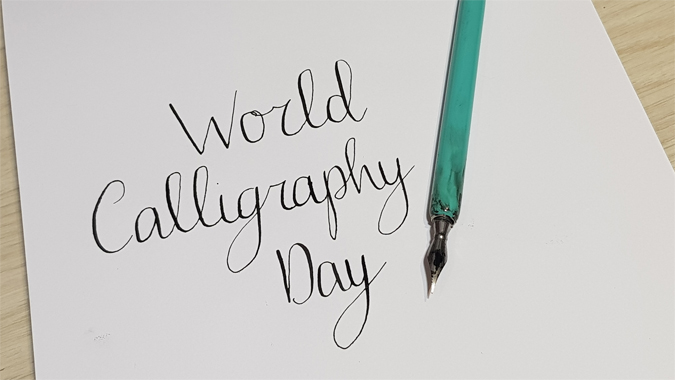| Date | August 9 |
| Founded by | Manuscript Pen Company |
| First celebrated | 2010 |
| Purpose | To appreciate handwriting as an artform |
World Calligraphy Day is celebrated annually on August 9th. This global celebration was founded in 2010 by the Manuscript Pen Company to highlight the importance of handwriting and calligraphy as an artform. In our modern digital age, the craft of artistic and decorative hand lettering is often overlooked. World Calligraphy Day aims to inspire appreciation for the history, skill, and creativity behind beautiful penmanship.
History of Calligraphy
Calligraphy derives from the Greek words “kallos” meaning beauty and “graphein” meaning to write. The art of calligraphy has been practiced for thousands of years across many cultures including Chinese, Arabic, Western, and others. Each culture developed distinctive calligraphy styles, techniques, and tools.
Chinese Calligraphy
Chinese calligraphy has over 4000 years of history dating back to the Shang dynasty. Chinese calligraphers use ink brushes to write characters based on thousands of years of evolution of Chinese script. Popular Chinese calligraphy styles include Seal Script, Clerical Script, Regular Script, Running Script, and Grass Script.
Arabic Calligraphy
Arabic calligraphy has evolved over the past 1400 years into diverse styles. Calligraphers use reed pens and ink to write flowing Arabic script. Common styles include Kufic, Thuluth, Naskh, Riqa’a, and Diwani.
Western Calligraphy
Western calligraphy emerged with the development of Carolingian minuscule and Roman square capitals in Europe. Well known Western calligraphy hands include uncial, half-uncial, and Gothic/blackletter scripts. Popular modern Western calligraphy styles are Spencerian and Copperplate.
How to Celebrate World Calligraphy Day
There are many fun ways for people around the world to engage in World Calligraphy Day celebrations:
Learn Calligraphy
Take a calligraphy workshop or class to learn calligraphy techniques, letterforms, and creative flourishes. Many craft stores, community centers, and colleges offer introductory classes.
Letter Writing
Write handwritten letters or cards to friends and family using calligraphy pens, brushes, and ink. Show appreciation through beautiful hand lettering.
DIY Calligraphy Projects
Create handmade calligraphy art, signs, invitations, thank you notes, or other DIY projects. Use calligraphy to decorate your home and gifts.
Visit a Calligraphy Exhibit
Seek out museums, galleries, libraries, or other institutions hosting calligraphy exhibits. View historical and modern calligraphic works.
Watch Calligraphy Demonstrations
Find calligraphy societies that host meetings with live demonstrations. You can also find calligraphy demonstrations online to admire the artistry.
Share on Social Media
Post your calligraphy creations on social media and use the hashtag #WorldCalligraphyDay to share your celebration worldwide. Follow calligraphers for inspiration.
Buy Calligraphy Supplies
Invest in starter calligraphy kits, dip pens, brushes, inks, chalk, guides and workbooks to start practicing calligraphy. Support specialty arts and crafts shops.
No matter how you choose to observe World Calligraphy Day, take time to appreciate the history and skill behind the art of beautiful writing. Calligraphy is a creative form of self-expression that deserves recognition.
Timeline of Calligraphy
- c. 1800 BCE – Early Chinese calligraphy on Shang dynasty oracle bones
- c. 600 BCE – Development of Phoenician alphabet precursor to Western scripts
- 100 BCE – Chinese invention of ink sticks, ink brushes, and Xuan paper
- 100 CE – Invention of reed pen for Arabic calligraphy
- 400 CE – Invention of bamboo pen in China
- 500s CE – Carolingian minuscule script developed in Europe
- c. 600 CE – Naskh Arabic script developed
- c. 700 CE – Invention of moveable type printing in China
- c. 1000 CE – Rise of Gothic blackletter script in Germany
- 1400s CE – Invention of metal dip pens in Europe
- 1900s CE – Popularity of Spencerian Script in America
- 2010 CE – First World Calligraphy Day
Quotes About Calligraphy
“Calligraphy is an art form that uses ink and a brush to express the very souls of words on paper.” – Kaoru Akagawa
“Calligraphy for me is a spiritual experience like meditation or yoga.” – Marek Czarnecki
“Calligraphy is painting with letters.” – Yadollah Kaboli Khansari
“You use a glass mirror to see your face; you use works of art to see your soul.” – George Bernard Shaw
“Lettering is to me the most artistic and satisfying medium in the graphic arts.” – Hermann Zapf
Hashtags for World Calligraphy Day
Celebrate World Calligraphy Day on social media! Here are some popular hashtags:
- #WorldCalligraphyDay
- #CalligraphyArt
- #HandLettering
- #CalligraphyOfTheDay
- #BrushLettering
- #ModernCalligraphy
Frequently Asked Questions About World Calligraphy Day
Here are some common questions about this celebration of artistic handwriting:
When is World Calligraphy Day celebrated?
World Calligraphy Day is celebrated annually on August 9th.
Who founded World Calligraphy Day?
World Calligraphy Day was founded in 2010 by the Manuscript Pen Company.
How can I celebrate World Calligraphy Day?
Ways to celebrate include taking a calligraphy workshop, creating calligraphy art, attending exhibits, sharing on social media, and more.
What is calligraphy?
Calligraphy is the art of beautiful and artistic handwriting. Calligraphers use ink pens, brushes, and nibs to create lettering.
What are some calligraphy styles?
Popular calligraphy styles include Chinese, Arabic, Western medieval blackletter, and modern Western pointed pen scripts like Copperplate and Spencerian.
Where did calligraphy originate?
Calligraphy emerged independently through history in different cultures including East Asia, the Middle East, and Europe.
What tools are used in calligraphy?
Calligraphy tools include dip pens, ink brushes, bamboo pens, reed pens, chalk, ink, and paper.
How long does it take to learn calligraphy?
It takes consistent practice over weeks or months to learn the basics of calligraphy styles, but it takes years to master advanced skills.

